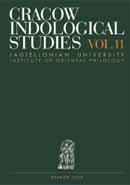Persian lexicography in India
Persian lexicography in India
Author(s): Kinga MaciuszakSubject(s): Language and Literature Studies
Published by: KSIĘGARNIA AKADEMICKA Sp. z o.o.
Summary/Abstract: For more than two centuries after the Arab Muslim conquest of Iran the Persian language had not appeared in any literary form. During the 10th century, the Samanid dynasty had established the dialect of it, known as Dari (dar ‘court’) as the court and literary language of their empire centred on Bukhara. This dialect included elements of other northern Iranian languages (Parthian, Sogdian, Khoresmian) and differed noticeably from the variant of Persian (Pārsī) spoken in southwestern Iran. The linguistic situation in the country at that time was even more complicated as the official language in the west was Arabic (e.g. at the Buvayhid court) and the Persian intellectuals of the region also wrote in that language. During the 11th century the prestigious Dari, the language of original poetry and prose started to expand its domain westward. Such famous poets of the east as Abu Hafs Sogdi and particularly Asadi Tusi (b. ca. 999-1000, d. 1072-1073) composed the first lexicons to explain the unfamiliar words and phrases of the chic Dari poetry for the people of Azerbaijan, who were less fortunate because they “could not speak Persian very well”.
Journal: Cracow Indological Studies
- Issue Year: 2009
- Issue No: 11
- Page Range: 183-212
- Page Count: 30
- Language: English

